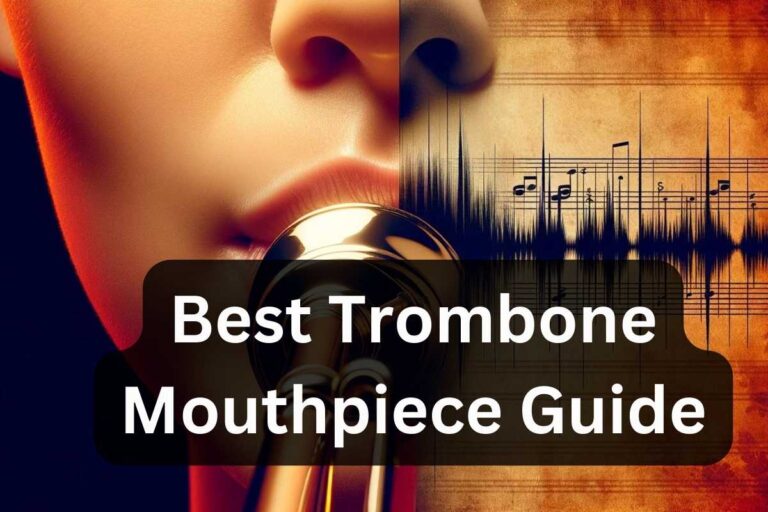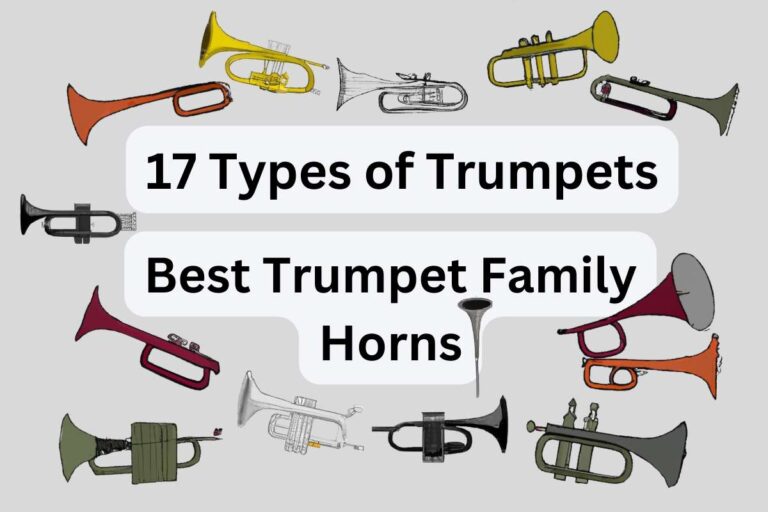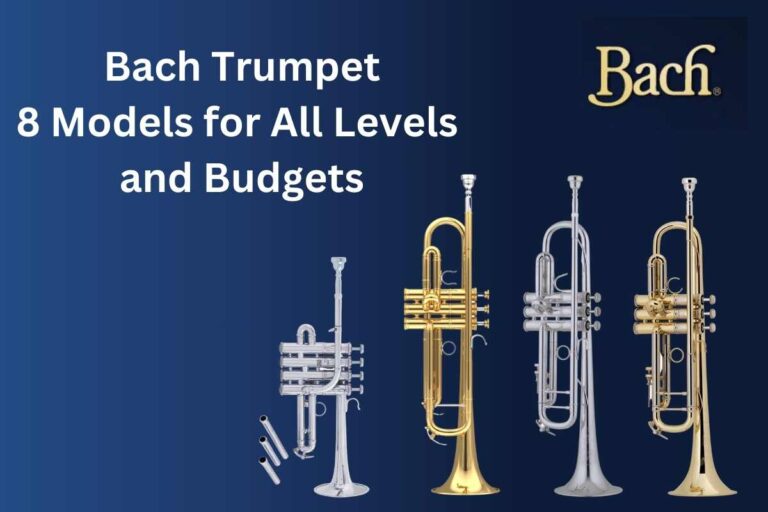What Are the Different Parts of a Flute? Full Anatomy Guide 🎶

In this guide, we’ll address an in-depth exploration of parts of a flute – each providing valuable information and a role in producing beautiful music! Knowing exactly what makes up each part can be intimidating if you’re new to playing this instrument. So without further delay — let’s dive right in and discover our beloved instrument together!
Begin with an overview of the parts that comprise a flute body: headjoint, lip plate, keyword and foot joint are key players when producing sound; we will explore modern flutes parts as well as anatomy lessons before discussing how all these parts combine to produce beautiful music! So come join us! Let’s get going!
Introduction to the Flute
For millennia, the Western concert flute has been a pivotal instrument in music. Due to its portability, the flute has proven popular across genres: from classical and orchestral performances to jazz and pop. Today it remains as one of the world’s favorite instruments – with many genres continuing its use as one component in multiple ensembles.
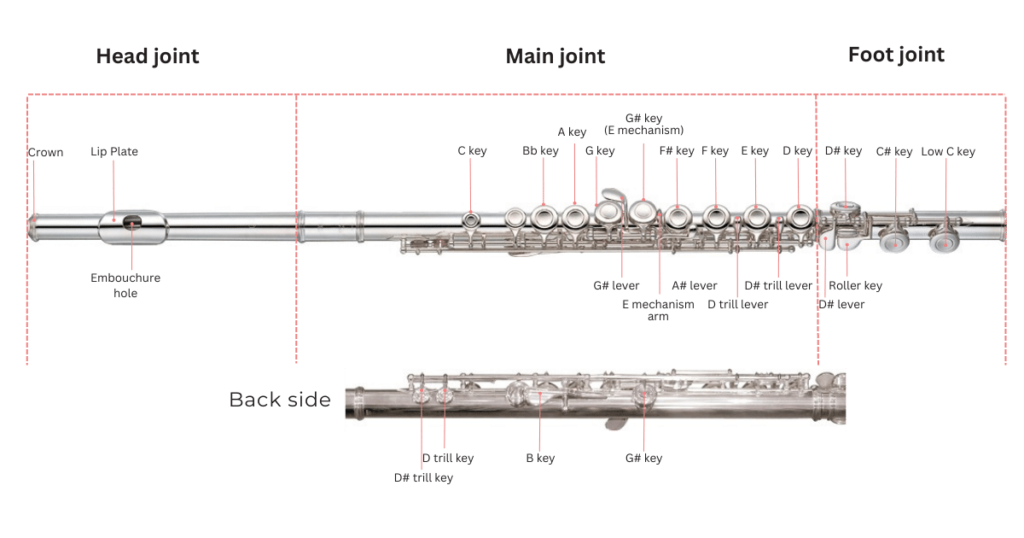
The flute is one of the world’s oldest and most beloved instruments. While most people know its basic form, there’s actually quite a bit of complexity behind its anatomy; we will explore all various parts of the flute together with their effects in creating its distinct sound in this article.
Head joint
The head joint of a flute is essential in its production of sound. Composed of metal tubes connected to its body with small openings for airtight sealing against player lips, this component amplifies and manipulates air vibrations created when blowing air through it to produce unique tonality for each instrument.
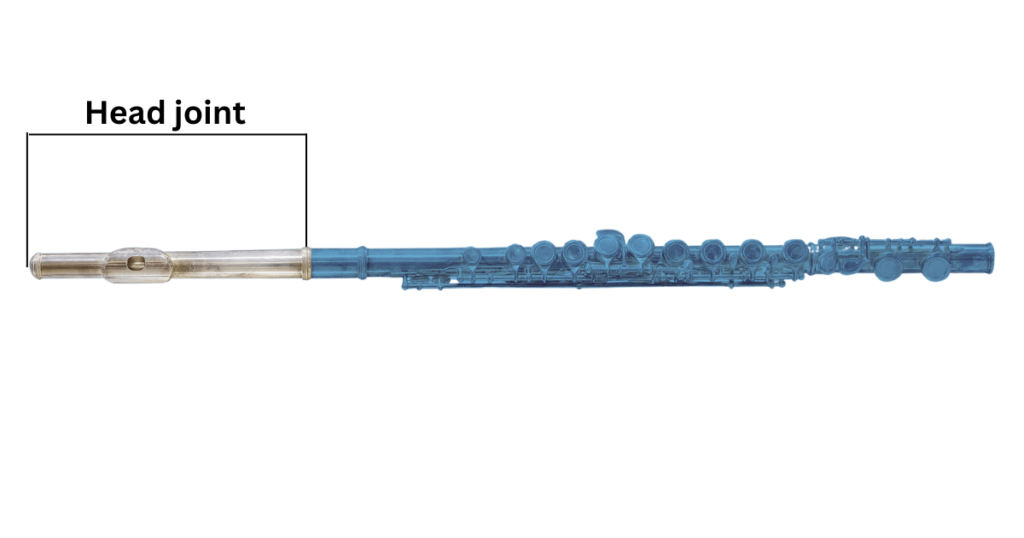
The head joint plays an integral part in setting the pitch of notes produced by the flute, as its various configurations and lengths alter the frequency of sound production. Acoustically designed head joints often combine cylindrical or conical forms for warmer, more focused sound production. Wall thickness has an impactful role as thicker walls provide resistance and require increased air pressure for an easier playing experience.
Head joint construction uses various materials, from sterling silver and gold to wood or even cardboard. Silver is often preferred because of its bright tone and relative affordability; gold creates an immersive sound experience and greater tonal flexibility. Wood produces darker tones for more soothing sounds.
Straight head joint
Straight head joints are by far the most prevalent style of flute head joint. Their traditional design boasts an even cylindrical form which provides for focused sound output while being easier to play than their curved counterparts.
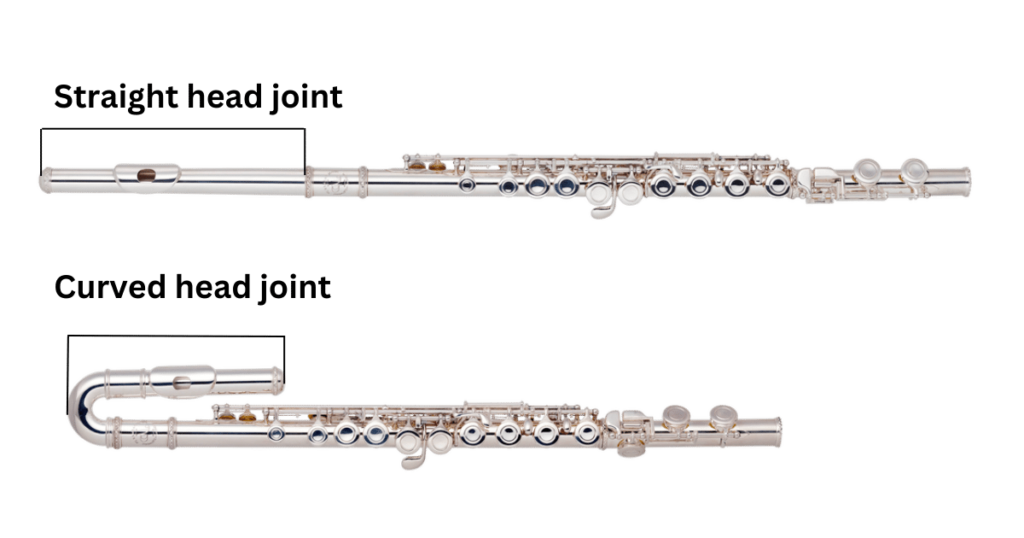
Curved head joint
Curved head joint flutes offer players another means of accessing more notes. Their bent head joint allows airflow along an angular path that produces higher notes per tone; plus their angle makes playing in higher registers much simpler as its angle helps create a better seal against lips.
Crown
The crown is located at the top of a flute. It serves to support the head joint, acting as an intermediary point between the head joint and the body. It provides extra support during playing sessions. Made of metal or resin and typically designed into either cone- or hemispherical shape.
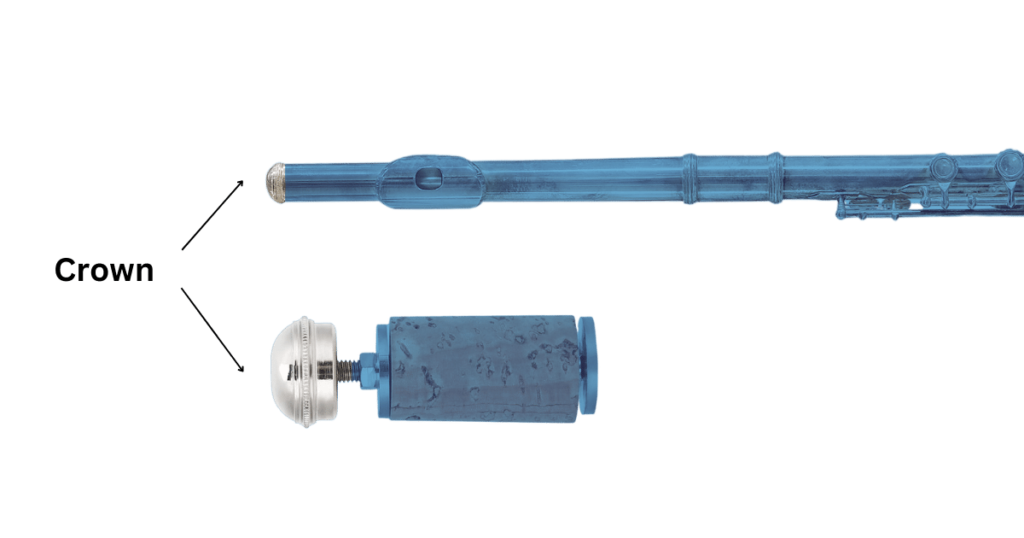
A stopper is a small piece of plastic, metal, or wood which fits securely into the end joint. It acts as an airtight seal to stop air from escaping during playing. Stoppers feature how much air escapes during the performance for greater control and a better playing experience.
To change a crown, remove it and the stopper from your headjoint, and fit the new stopper and crown onto it.
Crowns come in various sizes and styles, most commonly classified as heavy or open crowns. Heavy crowns provide extra support while open ones produce brighter sounds; both types of crowns will affect how a flute sounds when playing it. Having various stoppers available also has an effect on sound production from flutes.
Lip plate
A lip plate is a metal disc located within the head joint of the flute. It rests against players’ lips when playing to help form an air seal to create sound production and airflow. A poor fit between player lips and lip plate could disrupt airflow or sound production and should therefore be adjusted appropriately; otherwise issues arise regarding airflow and sound production.
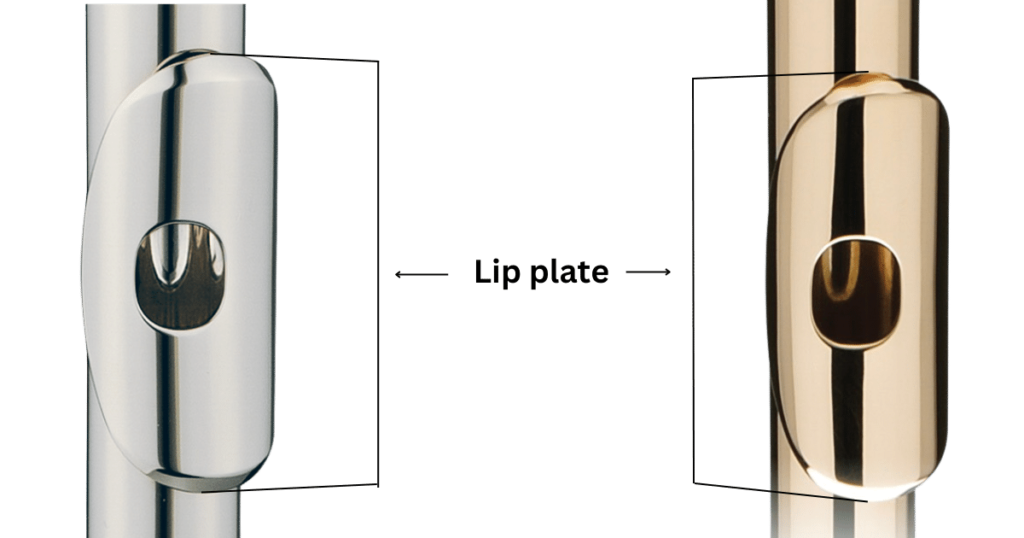
Theobald Boehm, who pioneered metal flutes, added a lip plate to make playing easier while maintaining a thickness equivalent to wood flutes.
Flute lip plate materials come in all varieties; silver and gold being among the more prevalent options. Silver is affordable but yields a brighter sound. The golden lip plate is for warmer, richer tones and for an improved experience.
Riser
A flute’s riser is a small tube located between its head joint and lip plate that helps regulate airflow throughout the instrument and acts as a bridge between these parts of the flute. A well-designed riser can improve sound production by connecting the head joint and lip plate better.
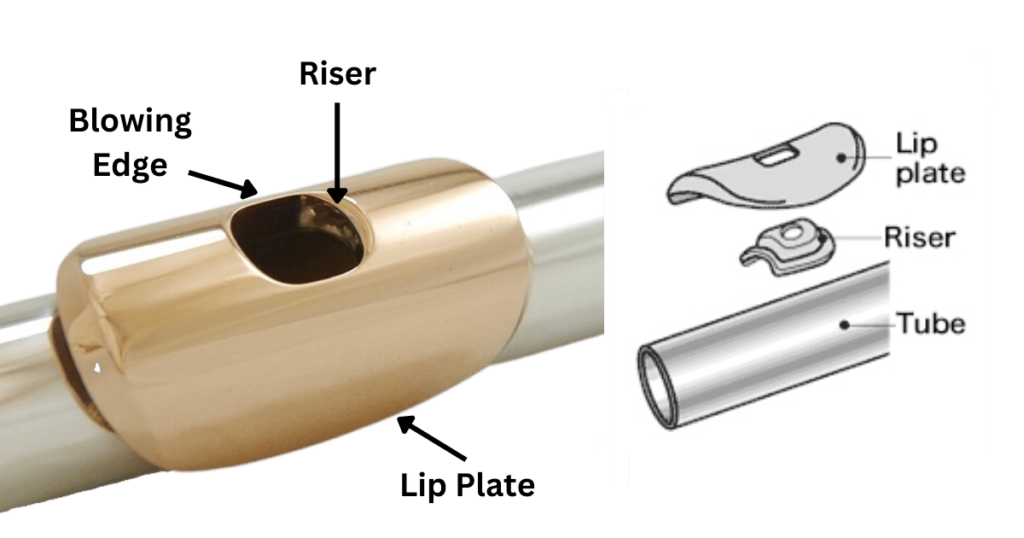
Materials used for risers (often called “chimneys”) vary, with silver, gold and platinum often being preferred choices.
Risers provide embouchure holes with depth. This determines both response and tone quality of a headjoint; generally a deeper chimney produces more low harmonics in sound for richer tonality, while shallow chimneys yield brighter, freer-blowing headjoints.
Embouchure hole – mouth hole
The embouchure hole of a flute is an opening at its head joint where air travels to produce sound. As its primary point of interaction between breath and lips with the instrument, its embouchure hole plays an invaluable role.
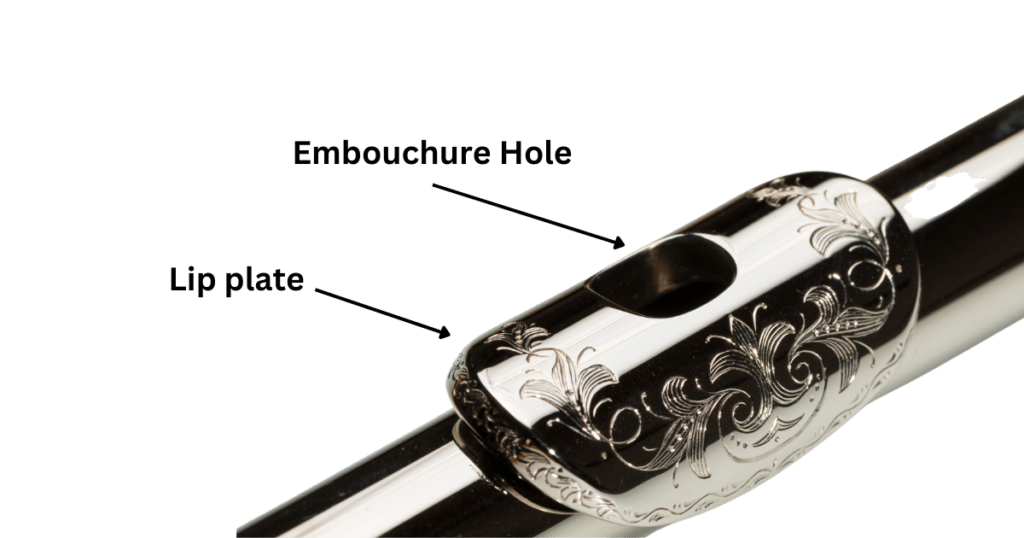
Emboucheure comes from the French for “mouth” and refers to the shape created when we blow into wind instruments such as flutes or trumpets. An effective embouchure ensures air flows correctly, produces consistent sound quality from these wind instruments. It also ensures consistent musical performances by players of the flute or clarinet.
The size and shape of embouchure holes have an influence over the sound produced by flute. Larger ones result in more open, resonant tones while tighter and narrower holes produce tighter, focused tones.
Different shapes may alter airflow and vibrational patterns; the most typical shape for an embouchure hole is round. Furthermore, individuals may choose their desired playing styles or replace existing holes as desired – all to help ensure all notes stay in tune!
Cork
Corks are small pieces of material located inside of head joints made up of rubber, cork or plastic that should fit securely so as to not move when playing. A cork should fit against the upper head joint of a flute to provide proper sealing against airflow during tuning and efficient airflow.

Cork can be adjusted to different lengths to meet individual player preferences and is often placed just above the lip plate in a head joint. Adjusting its position can significantly enhance intonation and response of the flute. It is usually put 17.3 millimeters off the center of the embouchure hole.
When replacing corks on flutes and piccolos, care should be taken to adjust them so as to maintain an airtight seal between their crown and flute embouchure hole – this will keep them in tune and produce superior sound production.
Tenon
A tenon is a metal end that connects the head joint of your flute to its body. Located inside its crown and with an opening over which fits a lip plate, its purpose is to hold down and secure its respective joint. It ensures the proper functioning of both components.
Over time, the headjoint tenon of a flute may become dirty due to regular usage. Do not force assembly if assembly becomes difficult to prevent damage; wipe down both outside of the headjoint tenon and within using a cloth-covered finger instead.
A tenon should fit securely without needing any lubrication — cork grease or other forms of lubricating oils only attract dirt, dust, and grime which will remain on it after assembly is completed. If there are difficulties when trying to assemble the instrument due to misalignment issues, visit a repair shop. It might require alignment issues to be rectified first.
Tone Reflector (Reflective Plate)
A tone reflector is a small metal plate located within the head joint of a flute. It is connected to its cork that acts like an amplifier for sound waves reflected off it, providing pitch information via tube length. A flutist uses the reflector as an adjustable device to control the sound brightness produced by their flute.

Reflectors should fit tightly within the head joint without shifting when playing flute, to maximize sound production from this instrument. Adjustment errors could radically change its tone quality.
Reflective plates may slip out of position, altering flute pitch. With this condition in play, hitting notes correctly could become challenging. To reposition reflective plates appropriately, loosen head screws and use the tip of your cleaning rod to push back into their proper positions.
Read this Yamaha article for a reflective plate inspection guide!
Body (Main tube)
The flute’s body joint contains its key mechanism for playing it and is home to tone holes that keys cover in order to produce various notes. It is the largest and most visible section where fingering techniques take place. The flute body contains tone holes that the keys cover when producing specific tones on different notes from its flute body joint.
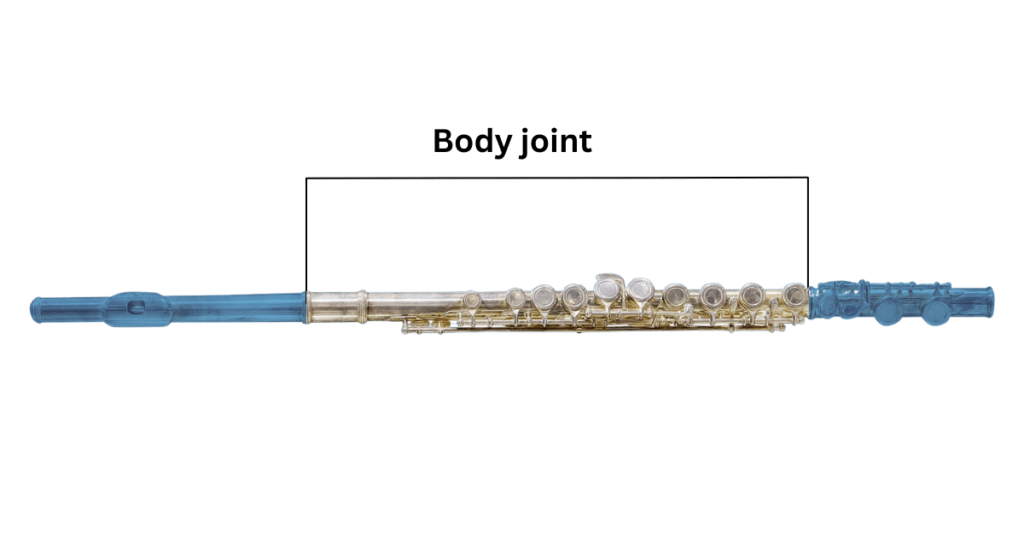
The body of a flute is its central tube and may be constructed of materials such as silver, gold, platinum and wood. As this component can often be one of its more costly parts, it will last many years with proper attention paid towards maintaining it.The body of a flute should be treated carefully. Store your instrument away from extreme temperatures or humidity levels to protect its optimal performance and extend its longevity. It prevents possible damage to its structure and keeps peak conditions for all times.
Barrel
An ornamental fluted area near the middle joint usually bears an engraved logo of its maker and is called the barrel.
A flute’s barrel is an area located at the top of its main tube that resembles a barrel in shape and serves no acoustic purpose; rather it adds visual interest while usually bearing an engraved logo of its manufacturer.
Keys
Flute keys control the sound produced by an instrument and are operated by pressing down with fingers on them to open or close tone holes and produce different notes. Flute keys consist of round metal covers covered by padding attached to metal rods in small sizes that feature fingering combinations by covering and uncovering holes to alter airflow within an instrument, increasing or decreasing pitch and creating variations that alter its overall airflow pattern.
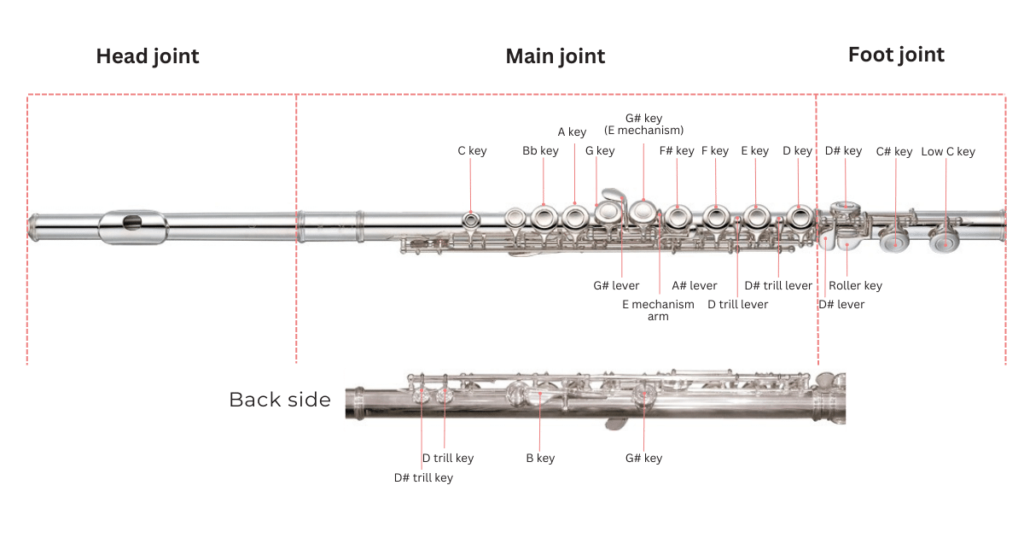
Flutes feature keys made from nickel or sterling silver that should be regularly oiled to maintain smooth operation and avoid sticking. Properly adjusted flute keys can enhance sound production and intonation; as such, regular examination of its keywork is paramount for optimal sound production and intonation.
Each flute key should move freely without resistance or sticking; any keys not operating optimally should be adjusted or replaced immediately.
Key spring
Key springs are integral parts of a flute that provide tension for its keys. Each key spring is composed of steel material with mechanisms enabling it to bounce back up when compressed down, making opening and closing tone holes much simpler and smoother.
Key springs can become weak with use, so regular inspection for wear or damage should be part of regular flute maintenance. Replacing worn or damaged key springs with new ones should also be part of routine care for maximum benefit; consult an expert technician for proper repair solutions for best results.
Keypads – Parts of a Flute
Keypads are parts of a flute which cover its tone holes, seal off airflow, and regulate it. Made of synthetic materials or felt, keypads should be periodically replaced to ensure an engaging tone quality in sound production and checked regularly for signs of wear or damage.
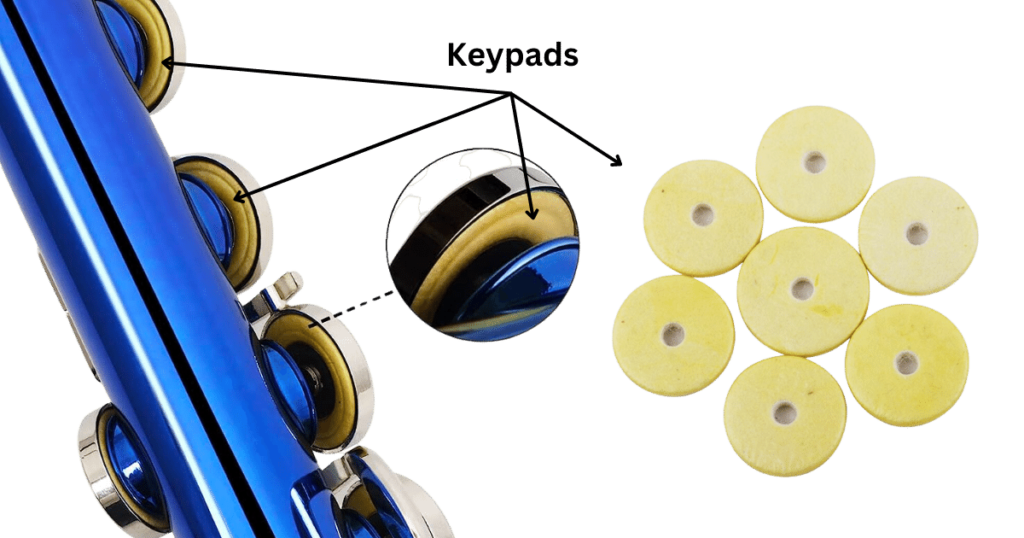
When replacing keypads on a flute, choose an appropriate material and size for its keypads. Incorporating thick keypads that fit snuggly into tone holes will produce more consistent sound and protect from potential damage to your flute.
Thumb Key – Bb lever (Thumb Bb)
Thumb Key (Bb lever) is an adjustable key that enables flutists to produce B-flat notes without using traditional fingering techniques. It is located underside the flute and operated with the left thumb.
There are three different finger positions exist to produce that Bb note. Hold down the B-flat thumb key while playing other notes (except high F# ). By holding down only the Bb lever you will change from B to B-flat while leaving all other notes unchanged.
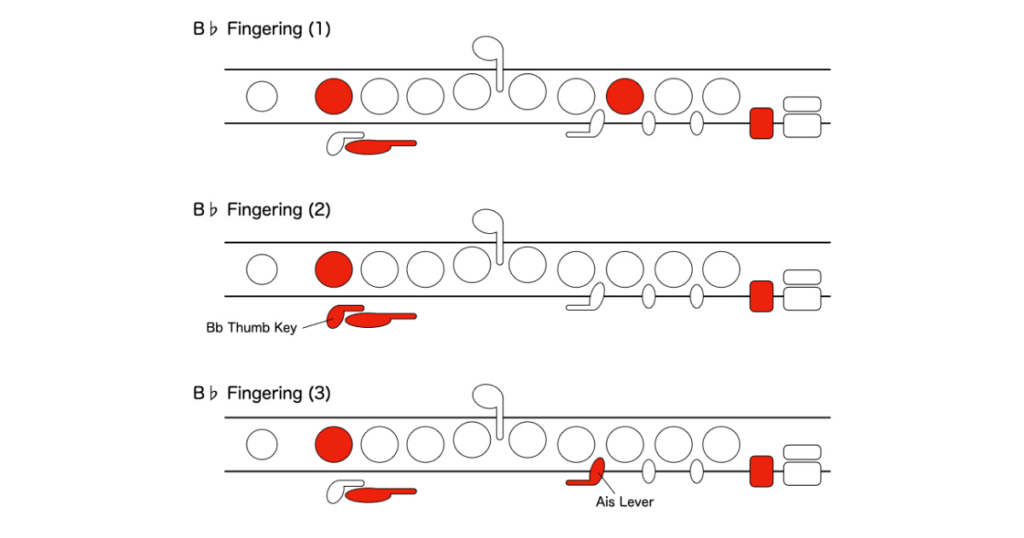
Adjusting the thumb key correctly is critical in producing clear and resonant notes from your flute. For optimal performance, position it so the spring compresses when closed; check that every time your flute assembles so the thumb Bb lever works as intended.
Open hole keys
Open hole keys on some flutes provide more control for their player over sound production. They allow a wider range of note alteration options and dynamic expression possibilities.
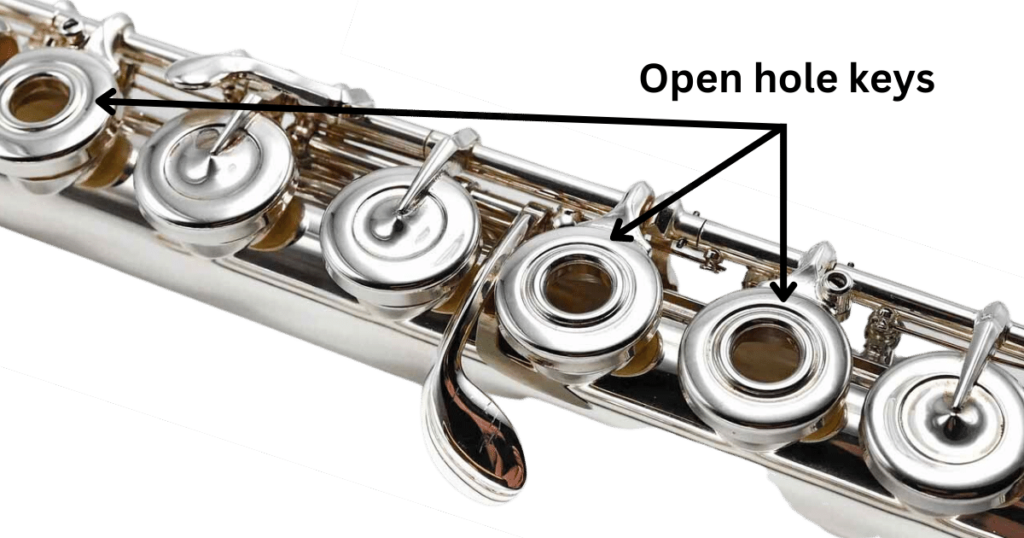
On an open holes flute, players have greater control over sound produced through partial closure of a small hole with fingers during playing – this provides precise control and more dynamic playing experiences.
Adjusting open hole key can be tricky since they need to be set exactly right to work efficiently. As professional repair technicians specialize in this adjustment, contacting one is the best approach for optimal functioning. Playing flute with open hole keys takes lots of practice – for the best result, it should be performed over time to create consistent sounds from your flute.
French open hole
French open hole keys flutes are designed to give players more control of their sound production while providing greater expression options.
French flutes have their name because of their origins at Paris Conservatory as benchmark flutes for advanced students. Each French keys flute contains five holes – three on the left and two on the right hand – to allow airflow through to create different tones and dynamics for sound production.
French keys flutes require significant expertise to play properly; many begin their flute journey by starting off on more basic flutes before progressing toward this type.
Closed hole keys – Plateau keys
Flutes with closed hole keys (also known as Plateau keys ) make for easier playing; their closed design offers resistance against your fingers, so they stay put during music playing sessions.
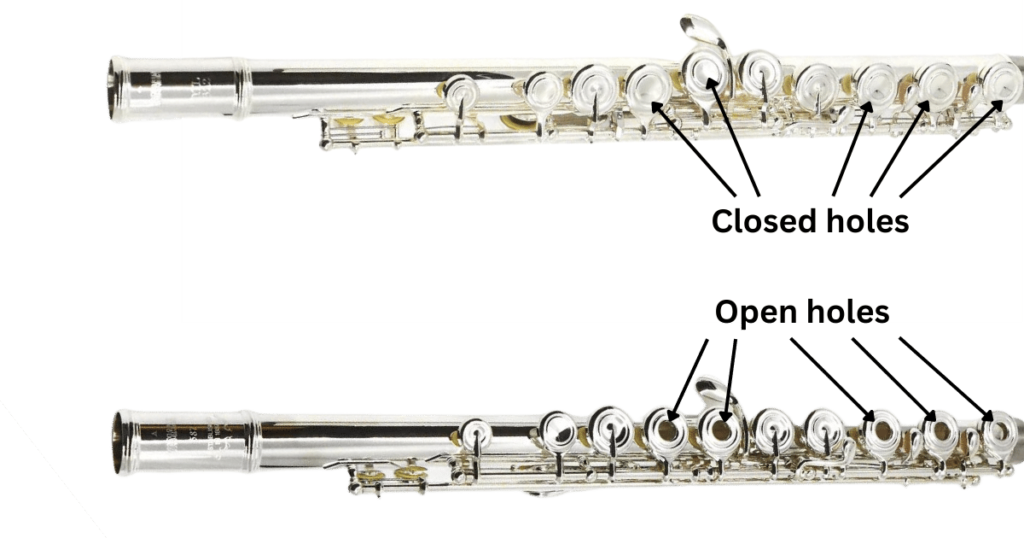
Younger students often prefer these flutes due to their ease of use and convenience, helping to develop even tones and good technique before transitioning onto open hole flutes. Closed hole keys consist of round metal covers with padding attached to metal rods.
Closed hole keys flutes are great beginner models and typically less costly, though the sound quality depends more upon its basic model than on any specific key type.
Offset VS Inline G flutes
Offset G flutes feature an easily accessible G key on their body for quick access to the keynote without stretching your hand excessively. Inline G flutes do not possess this feature and require greater finger skills for success in fingering the notes correctly.
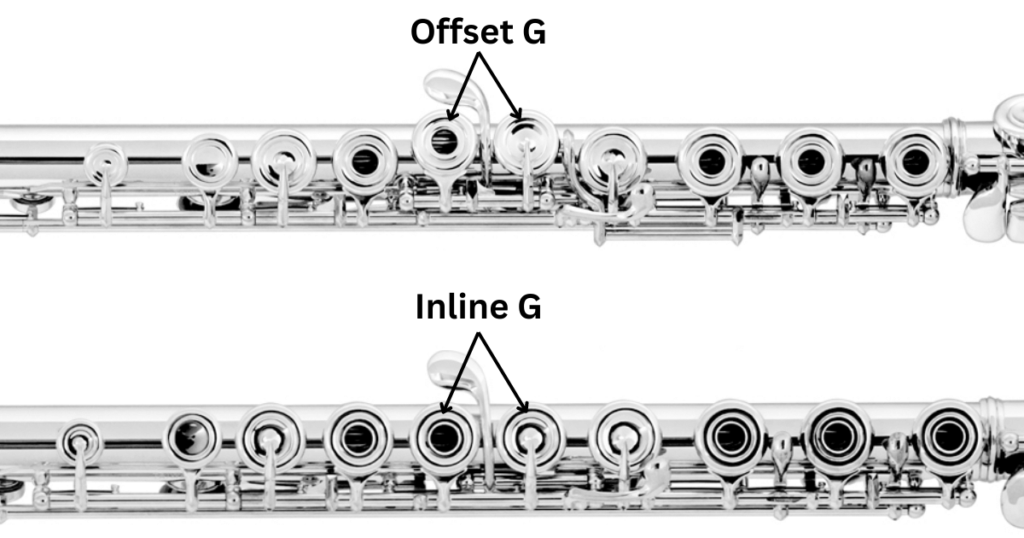
Offset G design accommodates our natural hand shape, which can help flute players avoid repetitive strain injuries (RSI).
A choice between online G flutes and offset flutes often boils down to personal taste; some musicians might prefer offset G flutes due to their ease of access and superior responsiveness.
Students with larger and longer fingers often prefer inline G flutes because it allows for easier learning of proper finger technique. For optimal comfort and less pain-induced playing experience however, offset G flutes should usually be started off.
Split E mechanism
A split E mechanism is an additional key mechanism found on certain flutes, enabling easier playing of high E notes without straining fingertips. It enables musicians to reach those notes easily.
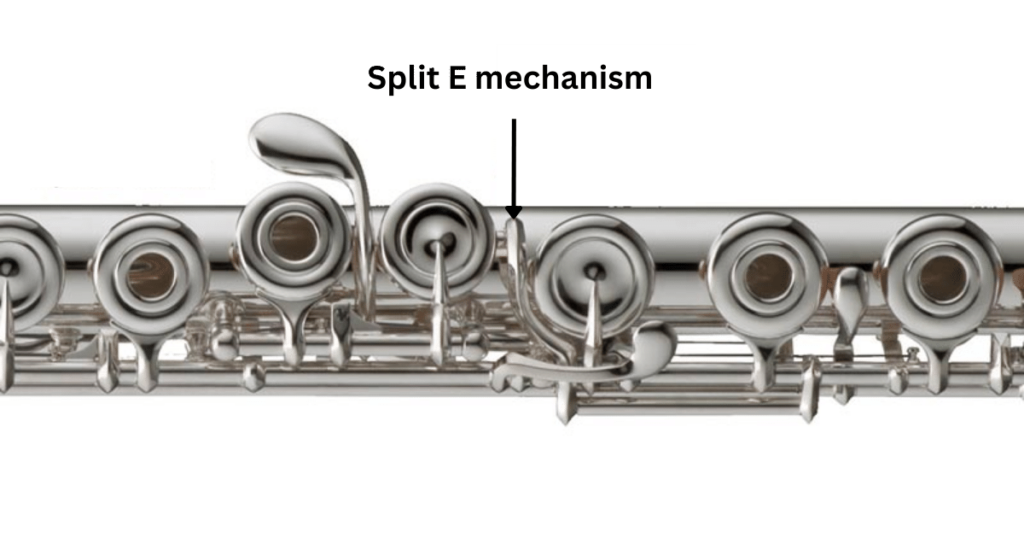
Split E mechanisms are highly useful when playing fast and intricate passages, particularly fast fingered passages that involve complex fingering patterns. When open, this key enables players to play high E notes without pressing other keys; when closed — it returns regular fingering patterns.
Foot joint
The foot joint is the final element in any flute. As one of its smaller components, this part can easily be detached for storage or transportation purposes. The body joint connects to the foot joint via a small tenon.
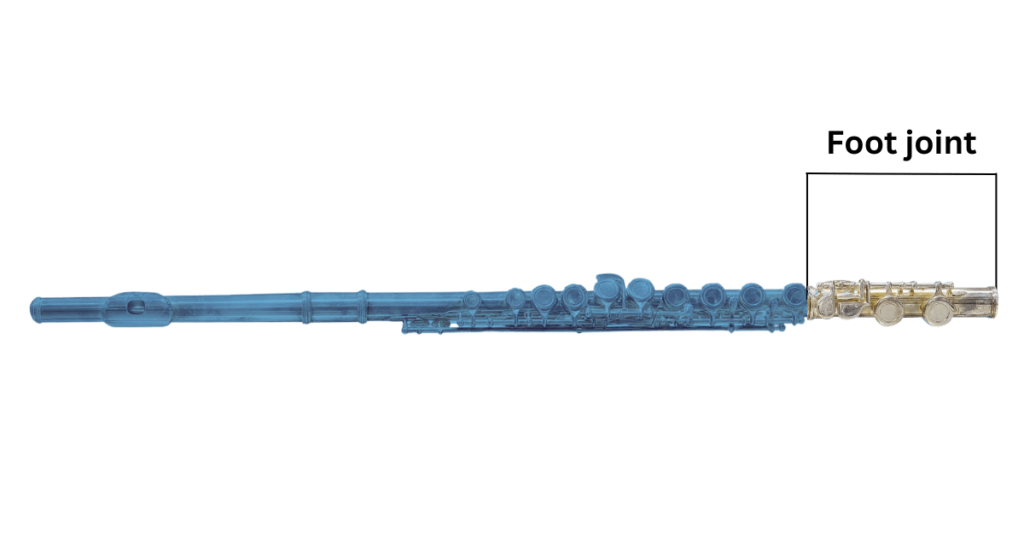
Foot joints of flutes are where the sound originates, usually consisting of only a few keys depending on its type and model; typically for low C, C sharp, B flat and possibly even thumb keys for easy access to low B with gentle downward movements.
Assembling and maintaining your flute should go smoothly for best results. Make sure the foot joint sits snugly on top of its body tube without gaps to guarantee consistent and clear sound production from your flute. Assembly and maintenance of your instrument are keys to its lifespan!
C foot joint
C foot joints feature two keys and two tone holes and produce the lowest note in middle C, commonly known as C4.
While commonly seen on flutes tailored for beginners, other foot joints may not be as popular.
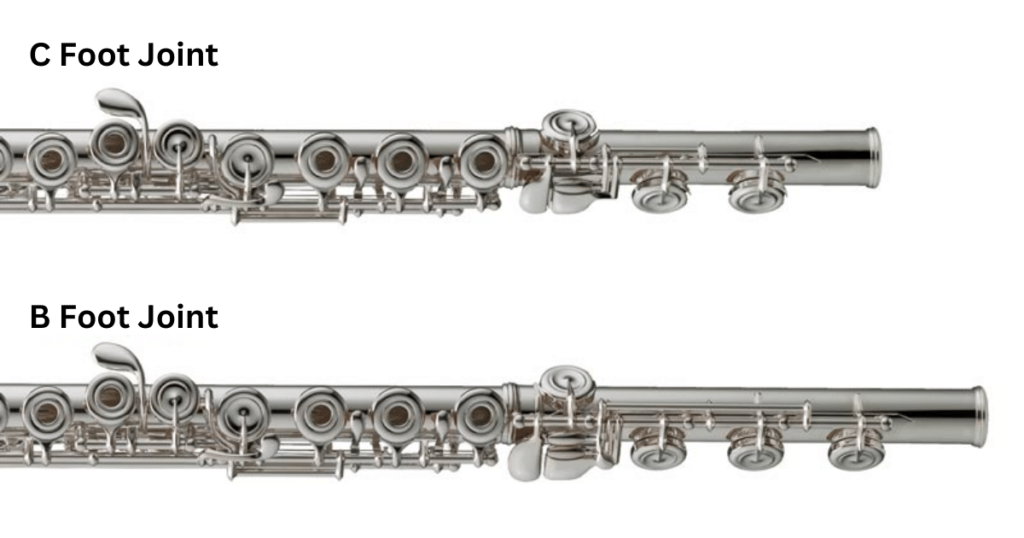
B foot joint
B foot joints feature three keys; this adds one more than what are found on C foot joints to produce B notes.
B foot joint flutes can produce that additional note and may sometimes be found among intermediate and professional flutes; however, most professional flutists opt for standard C foot joints instead.
The B foot joint adds additional weight to an instrument, which may become unbalanced over time for some players. As with all foot joints, mastery of this type may require more accomplished musicians’ time and experience before considering using one themselves.
Gizmo key
The Gizmo key refers to a small metal lever mounted on the foot joint on the flute. It allows a low B key to be depressed independently from other footjoint keys.
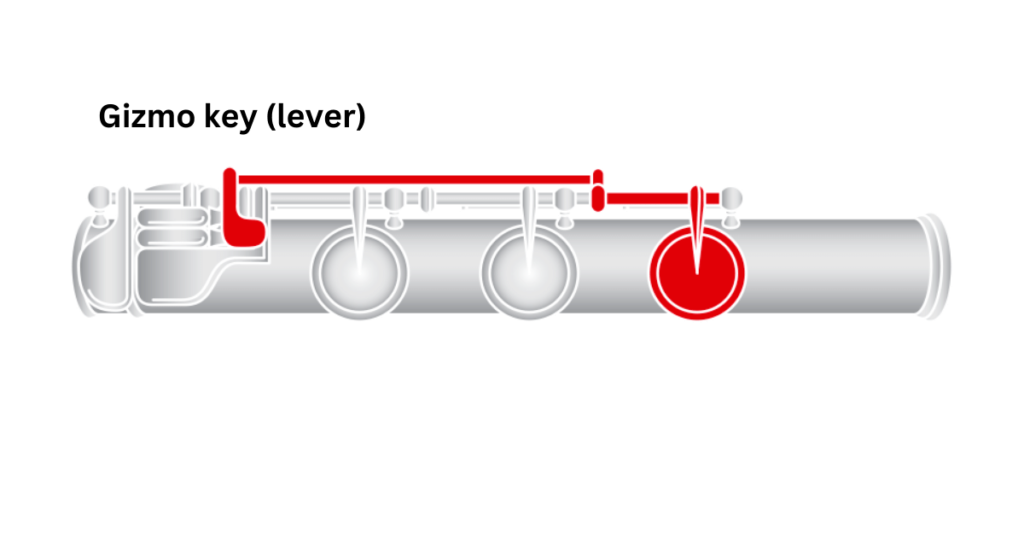
A gizmo key closes the low B tone hole while keeping C/ C# keys open, helping reach the 4th register of high C. It can typically be found on intermediate and professional flutes but may not always exist on all instruments.
No requirement exists to use that lever; many renowned flutists never used it – even during performances.
Conclusion
Understanding the anatomy of flutes (even bass flutes) will enable musicians to use it effectively to produce great sounds. No matter your level or experience as a flutist, being aware of all parts of the flute is key in beautiful music production.
Professional flutes require the key parts: embouchure plate, lip plate, head joint, foot joint and body. Keys enable air passage through various holes for creating musical notes while its keywork mechanisms are responsible for pitch altering – this comprehensive guide on what constitutes a flute will ensure years of musical enjoyment!
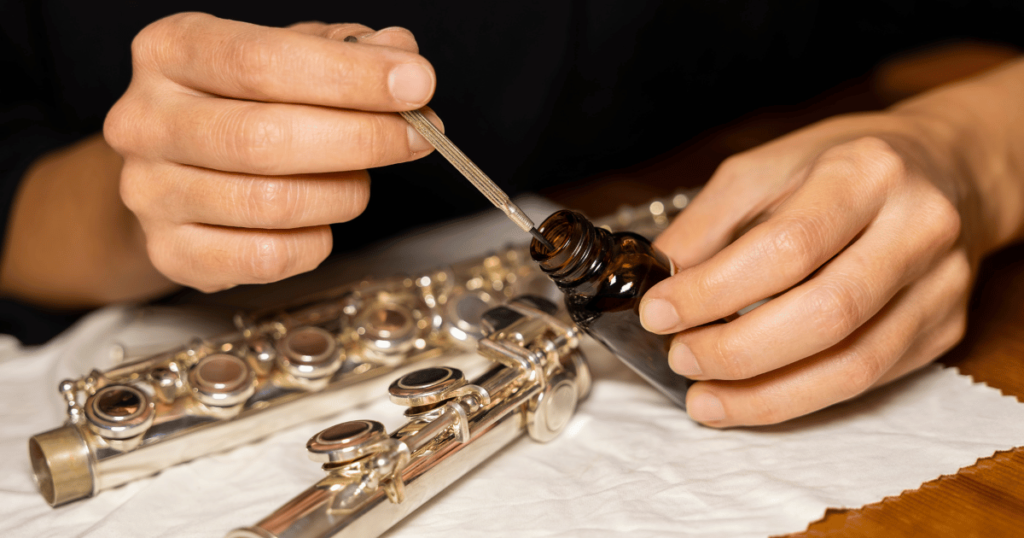
Thank you for reading our guide on the anatomy of a flute! We hope that you have gained an appreciation of its various parts of the flute by now, working together harmoniously to produce music! Now go forth and create some lovely tunes! Read our article, 13 Reliable Flutes Manufacturers for 2023, to become familiar with the leading flute brands.


